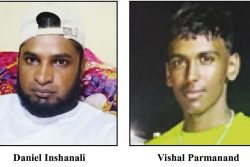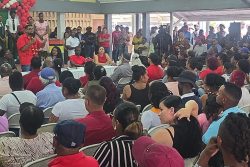Yesterday and on Friday this newspaper reported on the medical expenses of government officials paid for by the state during the period 2012-13. The amounts involved would have staggered the average taxpayer, especially if any of them were suffering from a serious disease requiring overseas treatment, and had been trying to solicit the assistance of the state. As was revealed, the government spent $361 million on health expenses, mostly for government officials, during the period in question.
As we reported, the late Presidential Advisor Navin Chandarpal was at the head of the list, with $116 million spent for cancer treatment. Attorney General Anil Nandlall’s medical expenses which were met by the taxpayer totalled $4.9 million, with “medical support” being listed as the diagnosis, while Minister within the Ministry of Agriculture Ali Baksh had a coronary bypass for which the state paid $12.2 million. The government also paid his air fare, which amounted to $249,600. It might be added that this is the first occasion on which the public has become aware that he had a bypass.
There were other officials too, such as Minister of Agriculture Leslie Ramsammy, who accounted for a more modest $1million, the late former Minister of Education Dale Bisnauth ($1.6 million) and Deputy Mayor Robert Williams, also now deceased ($2.1 million). Then there is Gitanjali Singh of the Audit Office and wife of Minister of Finance Ashni Singh, whose medical expenses in Canada together with her air fare amounted to over $3.4 million. Former Justice BS Roy was given $5.9 million for a coronary bypass which this time was done in Trinidad.
At the other end of the scale from $116 million, ordinary citizens suffering from cancer who requested various sums were granted anything from $400,000 to $5 million. As we reported yesterday, Stabroek News was told by an official from the Ministry of Health that patients would receive 25% of the cost of CT scans, MRIs and angiograms from the state. If they were unable to afford the cost after that, then they would have to visit the Minister of Health who would decide on a case-by-case basis if they should be assisted. Many of the patients at the Georgetown Public Hospital could not afford the treatment, but this newspaper was unable to find out what happened to them.
By far the most startling disclosure, however, concerned the substantial sums paid out to certain officials for dental treatment. Amerindian Affairs Minister Pauline Sukhai graced the front page of our edition yesterday with what was described as her “Million dollar smile.” That should have been put in the plural; she received $2.1 million from the government for dental work, and not to be outdone, Minister of Human Services Jennifer Webster was the recipient of $1.3 million. While Prime Minister Samuel Hinds was the beneficiary of a relatively minor sum, namely, $28,240, his wife, on the other hand, was granted $788,880.
Just to put things into context, in a letter to this newspaper in 2011, the Prime Minister wrote: “The records would show that the coverage for medical care was another discretion extended humanely, and provided to every single former President.” He was referring to Arthur Chung and Desmond Hoyte, the latter of whom had a coronary bypass. He went on to identify others from the opposition benches whose medical expenses he said had been paid by the state, including those of Robert Corbin, Franklin Everall and Sheila Holder. Exactly what the sums involved were was not stated, but the late Ms Holder was treated for cancer outside this country, while Mr Corbin was medevacked to the United States where he had a gall bladder operation. There was also the case of Winston Murray, but he was admitted to a local hospital and would consequently not have incurred the kind of expenses associated with overseas treatment.
There has been no suggestion to date that any opposition parliamentarian has had dental work done at taxpayer expense.
The problem with all of this is that there is no formula in existence for deciding in the first instance, which government officials and other public figures should qualify for medical assistance, or for outlining in general terms what kind of medical condition would qualify for assistance. There is also, it appears, no cap on how much is granted.
The first thing that should be said is that the conditions for which payments or reimbursement should be forthcoming should be of a fairly serious nature. Mostly in such circumstances certain specific treatment may not be available here, although that would not rule out payment for locally-based medical attention. Once upon a time, for example, kidney dialysis could not be obtained locally, but now it can be, and barring some additional or different kind of intervention in the case of failed kidneys, the state should not normally have to pay for overseas treatment.
What is almost impossible to defend is reimbursement for dental work of any kind, unless, perhaps, there is some medical issue involved as well. Ms Sukhai’s $2.1 million for dental work, for example, has an aura of indecency. (This sum accounted for half the total of $4.2 million for dental treatment.) Government officials – or any prominent figure, for that matter – should pay their own dental expenses, and should not be a burden on the taxpayer in this regard.
In this case what is worse is that given the size of the grant Ms Sukhai received, the temptation is to assume that it involved mostly cosmetic dental procedures. If that is indeed so, then it is totally unacceptable, and gives the impression, rightly or wrongly, that the state is paying to indulge vanity. Ms Webster, with her $1.3 million expenditure on dental procedures may or may not be in a similar category to Ms Sukhai.
Certainly rules should be drawn up during the course of the next parliament about who exactly – whether government or non-government – should qualify to have their medical costs defrayed by the state. Ideally, this should be done by the government in concert with the opposition, although from the vantage point of the present time the possibility of such cooperation might seem remote.
Furthermore, the matter of caps on the amounts payable should be worthy of consideration, so there is less distortion in terms of the sums disbursed for similar medical conditions involving similar treatment.
As said above, what is essential, however, is that rules and guidelines be laid down so that there is very much less ‘discretion’ involved in the process, although it would probably be impossible to eliminate it altogether. As things currently stand former presidents as well as current leaders of the opposition and their families are entitled to medical expenses – no caps specified. The case of the medevacking of former president Bharrat Jagdeo to Florida last year, caused some murmuring among citizens, because they perceived his complaint not to be major in nature.
In addition, once some kind of structured arrangements are in place, there should be complete transparency, and payments for the treatment of illnesses as well as information on the illnesses themselves in general terms should be publicly available. If taxpayers are footing the bill, they should know what they are footing the bill for, and the AG’s vague “medical support” after expending $4.9 million of public money, should not be permissible.
It has to be recognized, that whoever receives financial assistance at this level, is in a very privileged position. Ordinary members of the public sometimes with diseases whose outcome could prove fatal without sophisticated intervention, have to fight the bureaucracy to be granted even a fraction of what senior officials have been given without the frustration of penetrating the red tape. While it would be impossible to extend the payments privilege for senior officials to everyone, at least the procedures for the ordinary citizen could be simplified, and ways devised to be considerably more generous in terms of grants and reimbursements for the treatment of serious complaints.








